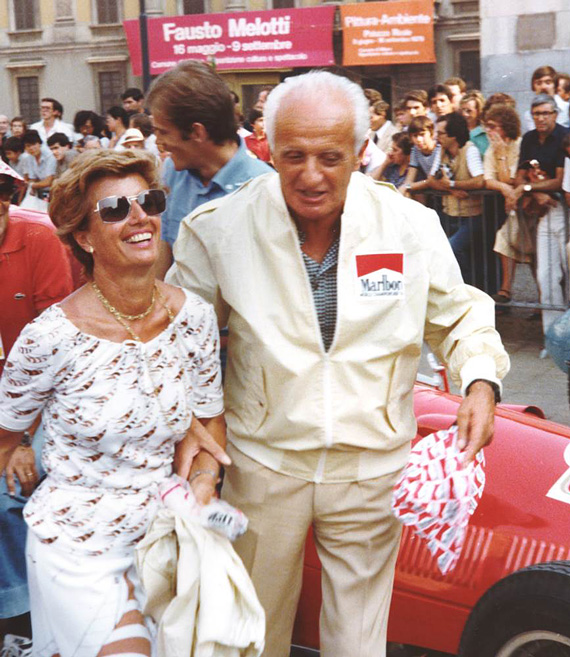
Maria-Teresa de Filippis and her fellow Maserati driver Luigi Villoresi enjoy themselves at a GPDC event.
By Graham Gauld
*Photographs provided by the collection of Maria-Teresa de Filippis
Farewell Maria-Teresa
After being involved with automobile racing for over sixty years one often feels inured to the passing of older drivers who you saw in action many years ago. However, Saturday last week was particularly difficult day as I was told the sad news that Maria-Teresa de Filippis had died. Theo Huschek, Maria-Teresa’s husband of fifty years, gave me the news.
The actual announcement came not as a surprise. Maria-Teresa had been suffering from a debilitating illness for a few years, but up until about a year ago you would never have known it. Just two months ago she celebrated her 89th birthday which was an achievement in itself, but her health went downhill sharply in the past weeks.
Maria-Teresa de Filippis started racing in Italy in 1948 after her brothers joked with her about becoming a racing driver. She entered her Fiat 500 Topolino in a hill climb and immediately won her class. She felt this would happen. She told me that a year before she had visited a fortune teller who told her that she would win a motor race and so it came to pass.
She came from an aristocratic Neapolitan family; her father was Count Serino Franz de Filippis, Narcisa, Anselmi, Balaguer, Roca de Togores y Ruco hu Perpignan. Maria-Teresa was the youngest of his children and his favorite. But it was her brothers who were first to go racing, Antonio buying one of the early “Monofaro” Maserati A6GCS sports cars with the single headlight on the grille. The car was s/n 2002, the second chassis built and originally run by the factory.
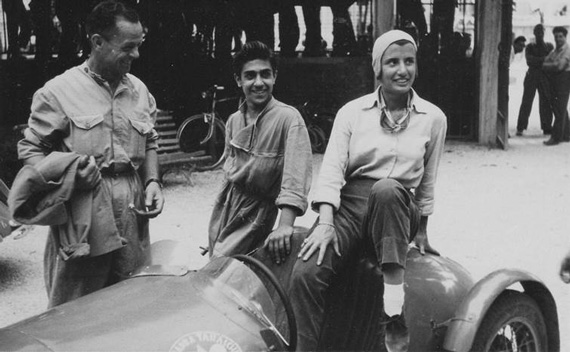
The Camen was supplanted by the Urania-BMW with its BMW motorcycle engine. It was very successful in the small capacity classes.
When she decided to go racing she needed a car and bought one of those many little Italian specials, the Camen-Fiat. It was built by the brothers Alfredo and Gugliemo Esposito who formed a company called called “Costruzzioni Automobili e Motore Esposito Napoli “ – hence CAMEN. However the car that was to make her name in those early days was a Urania-BMW built by Berardo Taraschi, himself a successful racing driver. Powered by a BMW motorcycle engine she ran this car in all manner of events in Italy and was usually successful in her class.
In the Giro di Sicilia in 1950 she rolled up to the start line but stopped short of her box so her mechanic ran forward and pushed her into place. She finished the race and then the organizers turned round and disqualified her, alleging her mechanic had given her a push start. She was enraged and a fellow competitor went to the organizers and complained: “You made a girl drive over one thousand kilometres on wet roads only to then disqualify her; this is crazy!” That driver was the great Tazio Nuvolari who had retired his Cisitalia-Abarth during the event. He and Maria-Teresa became great friends.
Her next car was an OSCA MT4 painted white with a red stripe along the side and this was followed in 1955 by her first Maserati, an A6GCS – one of the 1554 models and much later than the one her brother had bought. With this she did the Mille Miglia and many other events while making friends with legendary Maserati test driver Guerino Bertocchi, whom she always thought of as a father.
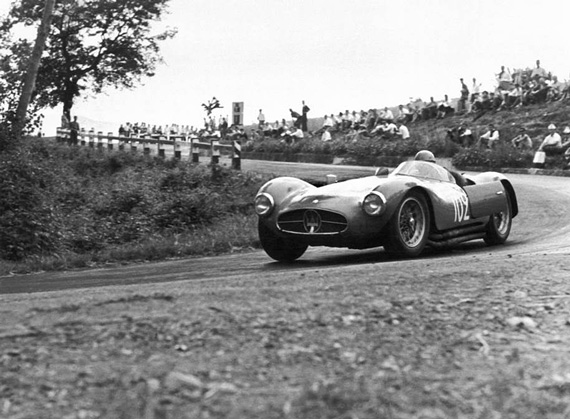
Her first Maserati was A6GCS chassis 2043 and she is seen here at Mugello in 1955. Note the door is open and when trying to close it she crashed heavily.
It was Bertocchi and Omer Orsi who persuaded her to move into Formula 1 with a Maserati 250F. She entered it for her first event, the Syracuse Grand Prix of 1958 where her former boyfriend, Luigi Musso, told her to follow him round the circuit so that she would know the lines. She did, and qualified. Although it was not a strong field, she finished fifth.
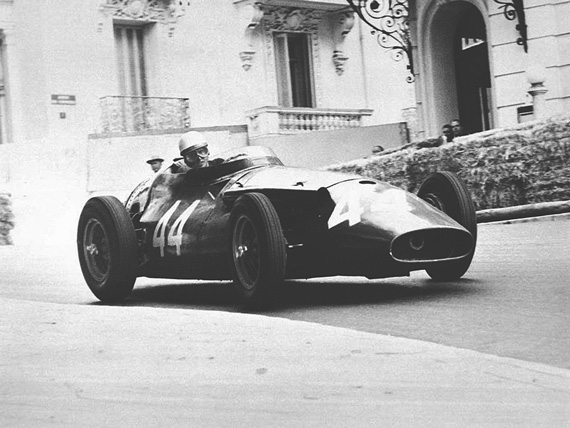
Trying hard at Monaco in the 1958 Gran Premio Siracusa with her “new” Maserati 250F but she did not qualify. It was her first Formula 1 Grand Prix.
However Maserati were in financial straits and were prepared to sell two of the new 250Fs that ran at the event. Maria-Teresa traded her car for the car Scarlatti had driven in Syracuse, so now she had the latest model.
At Monaco she did not qualify but she did qualify for the Belgian Grand Prix at the Spa circuit and finished 11th.
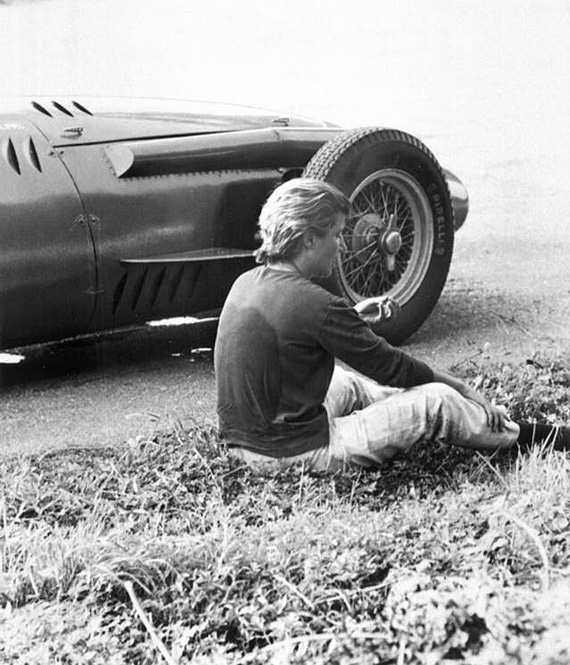
Sitting on the grass beside her stricken Maserati in the 1958 Italian Grand Prix. Note the pool of oil under the car. She was in pain with a stomach ulcer. Photo by Graham Gauld
I attended the Italian Grand Prix at Monza that year and for the first time saw Maria-Teresa in action. She proved to be very determined but towards the end she broke a con-rod and retired in a cloud of smoke. She happened to stop the car right in front of me and I photographed her sitting on the grass in pain. She did not realize that she was suffering from a stomach ulcer and went to hospital for treatment.
That season Orsi promised Maria-Teresa the latest Maserati Grand Prix car for the 1959 season. However, Maserati closed the competitions department and the deal fell through. However, her friend Jean Behra offered her his Formula 2 Behra-Porsche to race at Monaco as he had signed for Ferrari.
She was touched and told me she gave him a blank check “to pay for any damage I did to his car.” However the Behra-Porsche was totally uncompetitive and she did not qualify for the race even though it was said at the time she had made a time that would have allowed her to race.
When Behra was killed at Avus later that year Maria-Teresa retired from racing but there was a footnote. She told me “A few months after Jean died his widow sent me a letter and inside the letter was my blank check.”
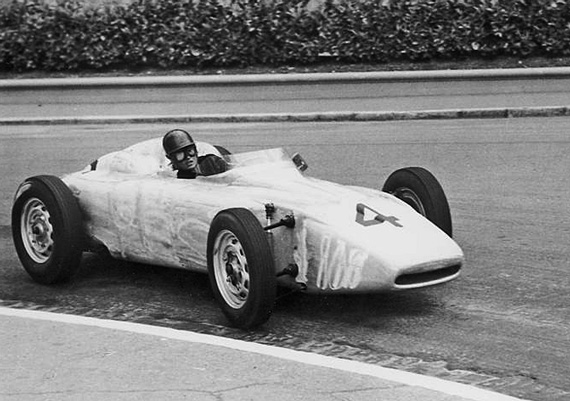
The unfinished Formula 2 Behra-Porsche at Monaco was her last Grand Prix attempt, in 1959, but it was not quick enough for her to qualify.
In 1960 on a ski-holiday in Austria, she met Austrian skier and enthusiast Theo Huschek and and six months later they were married. Maria-Teresa and Theo had a daughter, Carola, and eventually they had two grandchildren. By then she had joined the Grand Prix Drivers Club and became secretary, only to hand over the job to Theo, who is the secretary to this day. She threw herself into Club affairs and attended all the events until just a year ago.
Maria-Teresa may not have been the Ayrton Senna in her day but she was a far greater racing driver than many people think. Indeed Denis Jenkinson, that great doyen of Grand Prix racing, who watched her race her 250F1 Maserati for the first time, wrote in his 1958 report “An interesting sight at the Gran Premio Siracusa was to see a 26-year-old Italian girl driving a Grand Prix Maserati and not teetering round at the back of the field in an effeminate way, but having a real go ‘up with the boys’. This was Maria-Teresa de Filippis from Naples and, although it was her first outing in Formula One, she showed she was not frightened of the car, getting it into full-lock power slides through the corners and winding it up to well over 7000rpm in the gears.”
Those of us who were privileged to get to know her well and be entertained by her sense of humour will miss her.
*Photographs were provided by the collection of Maria-Teresa de Filippis; in most cases the photographer is unknown. If anyone has further knowledge of these photos please contact us at vack@cox.net.
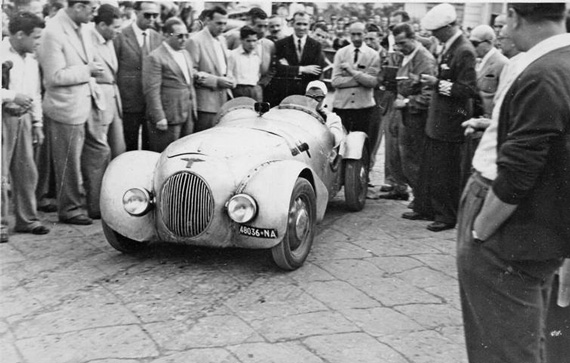
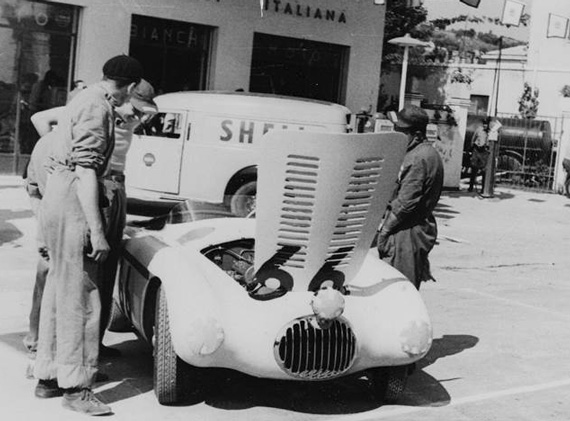
Pete:
Nice tribute. Peter Collins and I knew her well, and often met at European events until fairly recently. She was always up for a good joke. She arranged for me to meet Toulo de Graffenried who was going to do the forward for my Alfetta 158/159 book. He lived in a rather elegant ‘retirement’ home on a Swiss lake. Maria Teresa said ‘it’s very grand with wine waiters and they don’t play bingo’. and indeed she was right. she was very good at holding together the Anciens Pilotes group for some time.
EdMcDonough
Great article.
Over due for recognition….
Grazie.
It’s sad that she is gone. What an interesting life. Thank you, Pete and Graham Gauld, for bringing us the story of it. — Carl Goodwin
Thank you Graham Gauld for capturing the essence of Maria Teresa de Filippis as only you can. In the 67 years of the modern F1 championship, only five women have entered a grand prix and only two have qualified and raced. She was the first in 1958-9, but it would be 15 years before another woman, Lella Lombardi, would race in F1. I was fortunate to spend some time with her at the 2000 Monterey Historics when Maserati was reintroducing itself to the North American market. I found her an absolute delight with an engaging smile and interesting stories. The passage of time had not dulled the memories of the Pilotino (little racing driver) about her amazing racing days. I recall a quote from Motorsport after she moved to the Maserati works team in 1958. She said “Fangio told me I drove too fast, that I should try to go a little slower.” Fangio was actually referring to the reputation she had gained of having exceptional courage, even being a little too brave at times.
Another fascinating though sad article, Graham. She has obviously been a determined and talented lady to have competed to the level she achieved and a charming person.
A lovely story Graham. As usual something ‘different’ and interesting and told with enthusiasm and honesty.
Another fine job by Graham Gauld–real Gold !
I always admired her as driver and pleased to learn more
‘of here early days in those typical small Italian events. You
could just remain in Italy and enjoy plenty of racing on
Real roads.!
My own personal records for her only begin in 1953 with
that OSCA which carried odd livery(rather like the one
‘for Louis Chiron?)
Wonderful to have Graham speak of her new 1954 type
Maserati,
2000 sports and it would seem that she also purchased the
infamous V-12 Maserati GP car at end of 1957 season, according
to Denis Jenkinson who really did keep track of such matters !
I would be grateful to see more photos of this lady who really
could drive.!
Jim sitz
We agree, Gauld is a treasure. If you want to read more of his work, just type in Gauld in the ‘Search this site’ box at the top of the right column, and all of his stories will appear.
Editor